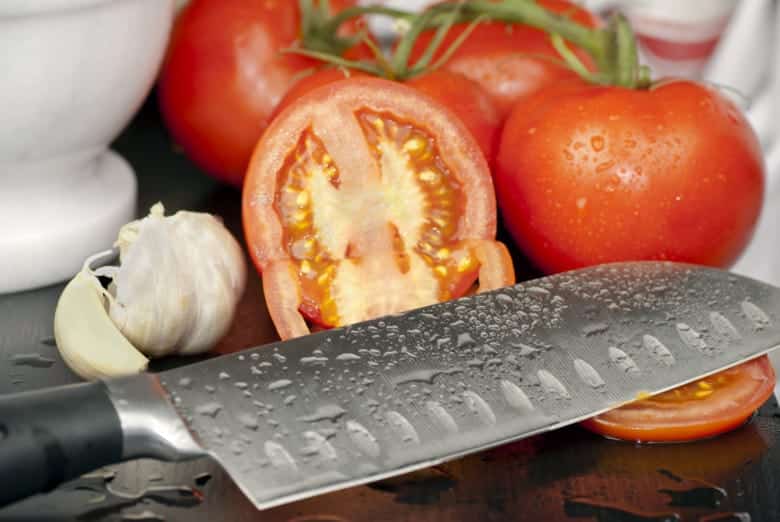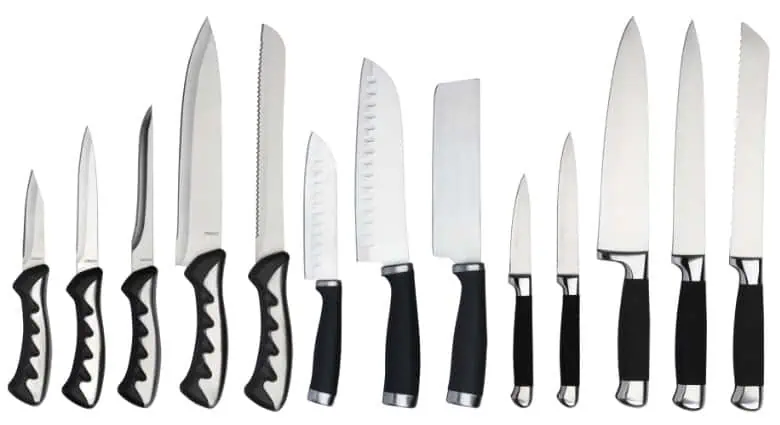When it comes to prep work in the kitchen, a good knife can make all the difference. There’s a multitude of options when it comes to blades, but two specific types stand out in terms of functionality and performance: nakiri vs santoku knives.
Nakiri knives are designed primarily for slicing, dicing, and chopping vegetables. Whereas the santoku is similar to a chef knife in that they’re great general-purpose knives. They have some differences in their shapes, which affect their cutting styles and techniques.
I’ve spent a great deal of time researching and comparing the two, so let’s dive into the details and find out what makes these knives unique and which might fit your kitchen needs.
A nakiri knife has a rectangular blade with a straight edge, which is ideal for chopping straight down and making precise cuts. It is also typically thinner and lighter than a santoku knife, making it easier to handle and maneuver.

On the other hand, a santoku knife has a wider blade with a slight curve, which makes it more versatile for chopping, slicing, and mincing. It also has a slightly heavier blade, which can make it easier to cut through denser vegetables or meats.
Overall, the choice between a nakiri and santoku knife depends on personal preference and the specific tasks you will be using the knife for. If you primarily chop vegetables and want a knife that excels in precision cutting, a nakiri knife may be the better choice. If you need a more versatile knife that can handle a variety of tasks, a santoku knife may be the way to go.
I’ve found some great knives to compare below.
Nakiri Knives
Shun Cutlery Classic Nakiri 6.5″ Knife
If you’re in search of a top-notch vegetable-cutting knife, the Shun Classic Nakiri Knife is a must-have addition to your kitchen.
I recently had the pleasure of using the Shun Cutlery Classic Nakiri Knife, and I must say it’s been a game changer in my kitchen. The 6.5-inch blade is perfect for slicing and dicing fruits and vegetables with ease.
The straight blade and flat edge make push-cutting a breeze, and the absence of a sharp tip adds an element of safety. Meanwhile, the comfortable ebony-finished Pakkawood handle fits wonderfully in my hand and looks great in the process.
However, it’s important to note that the knife is designed specifically for right-handed users. Left-handed chefs may find it less comfortable to handle. Additionally, the delicate nature of the blade and the premium materials require proper care and attention, like hand washing and avoiding the dishwasher.
Overall, if you’re in the market for a high-quality nakiri knife and are willing to invest in proper maintenance, this Shun Cutlery Classic is an excellent choice. It’s also available with a beautiful blonde wood handle, the Shun Classic Blonde Nakiri. After this review, I bought one and it’s a stunner!
Pros
Cons
DALSTRONG Nakiri Vegetable Knife – Shogun Series X
As a versatile and high-quality 6-inch vegetable knife, the DALSTRONG Nakiri definitely deserves your consideration.
The DALSTRONG Nakiri Vegetable Knife was a pleasure to use. The AUS-10V Japanese steel provides a razor-sharp edge, coupled with the thinness of the blade allowing the knife to glide through the densest tubers and stalks.
The striking design of this knife, including the Tsunami-rose Damascus layers and hammered finish, truly sets it apart from the competition. Not only does it look great in the kitchen, but the hammered finish also helps reduce drag and minimizes food sticking to the blade.
After working with this knife for a while, I’m impressed by the comfortable and ergonomic G-10 handle, which has made long meal preparations feel like much less work. While it may be a bit pricier than other vegetable knives, I believe the DALSTRONG Nakiri is a worthy investment for those serious about their kitchen tools.
Pros
Cons
Wusthof Classic 7″ Nakiri Knife
Wusthof is known the world over as a premier kitchen knife brand. Although located in Germany, they have a line of top-quality Japanese-style knives. One of which is the Classic 7″ Nakiri knife, a high-quality vegetable knife that is designed for precise and efficient chopping, slicing, and dicing of fruits and vegetables.
It features a sharp and durable hollow edge blade made of high-carbon stainless steel, a comfortable and ergonomic handle made of synthetic material, and a full tang construction for optimal balance and control. The knife also comes with a lifetime warranty and is dishwasher safe (although I recommend handwashing).
Pros
Cons
Santoku Knives
Shun Cutlery Dual Core Santoku Knife 7 Inch
The Shun Cutlery Dual Core Santoku Knife is a top-quality choice for all-purpose food prep with excellent balance and sharpness.
I recently had the pleasure of using the Shun Cutlery Dual Core Santoku Knife in my kitchen, and I have to say it’s a fantastic tool for all sorts of food prep tasks. The 7-inch blade easily handles basic kitchen cutting tasks, and the blend of high-carbon, high-chromium VG10 and VG2 stainless steel creates a razor-sharp, long-lasting edge.
The traditional octagon-shaped, ebony-finished Pakkawood handle is not only beautiful but also provides a comfortable and secure grip. This knife is shorter than a standard chef’s knife, making it light and easy to maneuver with just enough curve for rocking cuts. As someone who appreciates artisan craftsmanship, I can tell that the skilled Japanese artisans who created this knife put a lot of care into its design and construction. Considering the price, they better have!
While the Shun Cutlery Dual Core Santoku Knife is a high-quality and beautiful choice, it’s important to keep in mind that its brittle cutting edge may chip more easily than other knives. This means you’ll need to handle this knife with care and avoid cutting hard root vegetables or other tough items that could damage the blade. Despite its price, you’ll definitely notice the difference in performance if you’re willing to invest in this exceptional knife.
Pros
Cons
Mercer Culinary M20707 Genesis 7-Inch Santoku Knife
The Mercer Culinary M20707 Genesis 7-Inch Santoku Knife is a great investment for anyone who loves to cook. It’s a versatile knife that can be used for a variety of tasks, from chopping vegetables to slicing meats. Although not as stylish as the Shun Dual-Core (above), it’s a fraction of the price and simply a great knife. No wonder it’s so popular. Many chefs prefer buying less expensive knives. This way they don’t have to worry so much about maintaining or damaging the blade. If this sounds like you, this may be the perfect choice.
Pros
Cons
Dalstrong 7-inch Santoku – Valhalla Series
If you’re looking for a versatile santoku knife for your kitchen, the Dalstrong 7-inch Valhalla Series Santoku is another excellent addition.
I recently used the Dalstrong 7-inch Santoku from their Valhalla Series and am quite impressed with its performance. The high carbon steel blade, forged at a 60+ Rockwell hardness, ensures sharpness and durability, allowing me to channel my full power into every slice. Also, it has an unusual tip making it look much more aggressive than most santoku knives.
The celestial resin handle, reinforced with stabilized wood and stainless steel, not only gives the knife a stunning appearance but also provides me with a sturdy and comfortable grip. The leather sheath, embossed with the Valhalla logo, ensures it stays protected when not in use, which is immensely practical.
Despite its undeniable advantages, the knife may be considered too light for some users, and it might not be suitable for heavy-duty tasks. Additionally, the price may be on the higher end for some budgets. However, considering its quality and performance, I believe the Dalstrong 7-inch Valhalla Series Santoku is an investment worth making.
Pros
Cons
Related: Santoku Vs Chef Knife. Best Choice And Brand For You.
Buying Guide
Here’s a guide on what to look for when buying these knives.
Blade Material
The blade material is one of the most important factors to consider when buying a nakiri or santoku knife. High-carbon stainless steel is a popular choice for both types of knives because it is durable, rust-resistant, and holds a sharp edge for a long time. Other materials to consider include Damascus steel, VG-10 steel, and AUS-10 steel.
Blade Size
The size of the blade is another important factor to consider. Nakiri knives typically have a blade length of 6-7 inches, while santoku knives typically have a blade length of 5-7 inches. The size of the blade will depend on the tasks you plan to use the knife for. If you plan to chop vegetables, a nakiri knife with a longer blade may be more suitable. If you plan to chop meat or fish, a santoku knife with a shorter blade may be a better choice.
Blade Shape
The blade shape is another important factor to consider. Nakiri knives have a straight blade that is designed for chopping vegetables in an up-and-down or push-cut motion. Santoku knives have a curved blade that can handle just about anything including a rocking motion similar to a chef’s knife. Your choice of shape will depend on the tasks you plan to use the knife for.

Handle Material & Shape
The handle material and shape are also important factors to consider. The handle should be comfortable to hold and provide a good grip. Common materials include wood, plastic, and stainless steel. Wood handles are popular because they are comfortable to hold and look great. Plastic handles are popular because they are easy to clean and maintain. Stainless steel handles are great since they so are durable.
Weight
The weight of the knife is another important factor to consider. Nakiri knives are typically lighter than santoku knives because they are thinner. Santoku knives are designed for chopping meat, fish, and vegetables, so they are sturdier (but still lighter than more chef’s knives). If you spend long periods of time prepping food you may prefer a lighter knife to prevent fatigue. On the other hand, the extra weight of a heavier knife makes cutting through tougher food feel a lot easier.
Price
The price of the knife is another important factor to consider. Nakiri and santoku knives can range in price from $20 to $300. What you’re willing to spend is a personal decision but you should be able to find a top-quality knife santoku or nakiri for between $100 – $200.
Country Of Origin
Where a knife is made is also an important factor to consider when buying a nakiri or santoku knife. Japan is known for producing high-quality knives, so knives made in Japan are often preferred by professional chefs and home cooks alike. However, there are also high-quality knives made in other countries such as Germany, France, Sweden, and the U.S. It’s important to do your research and read reviews to determine the quality of the knife, regardless of where it is made.
Related: Kitchen Knife Buyer’s Guide: Tips For The Perfect Choice
Final Thoughts: Nakiri Vs Santoku
If you’re in the market for a great all-purpose knife you can’t go wrong with a santoku. Like a chef’s knife, a santoku can meet most of your cutting needs in the kitchen. A nakiri is a specialized knife with a thinner blade, designed specifically for chopping fruits and vegetables. It’s the perfect knife for vegans. Most well equipt kitchens will have both of these Japanese knives in their collection.
Finally, when buying a nakiri or santoku knife, it’s important to consider the blade material, size, shape, handle material, weight, and price. All 6 of the knives in this article are winners but my personal favorites are Shun Cutlery Classic Nakiri 6.5″ Knife and the Mercer Culinary M20707 Genesis 7-Inch Santoku Knife.






